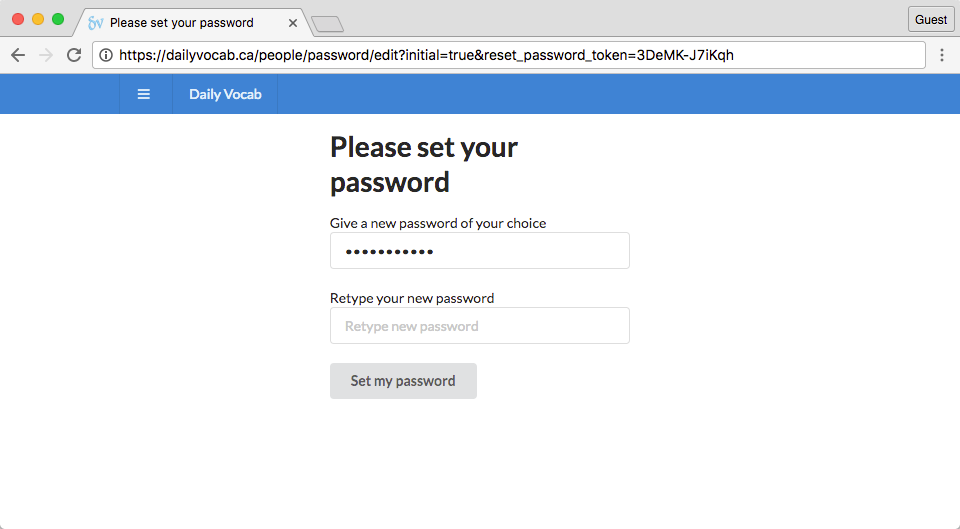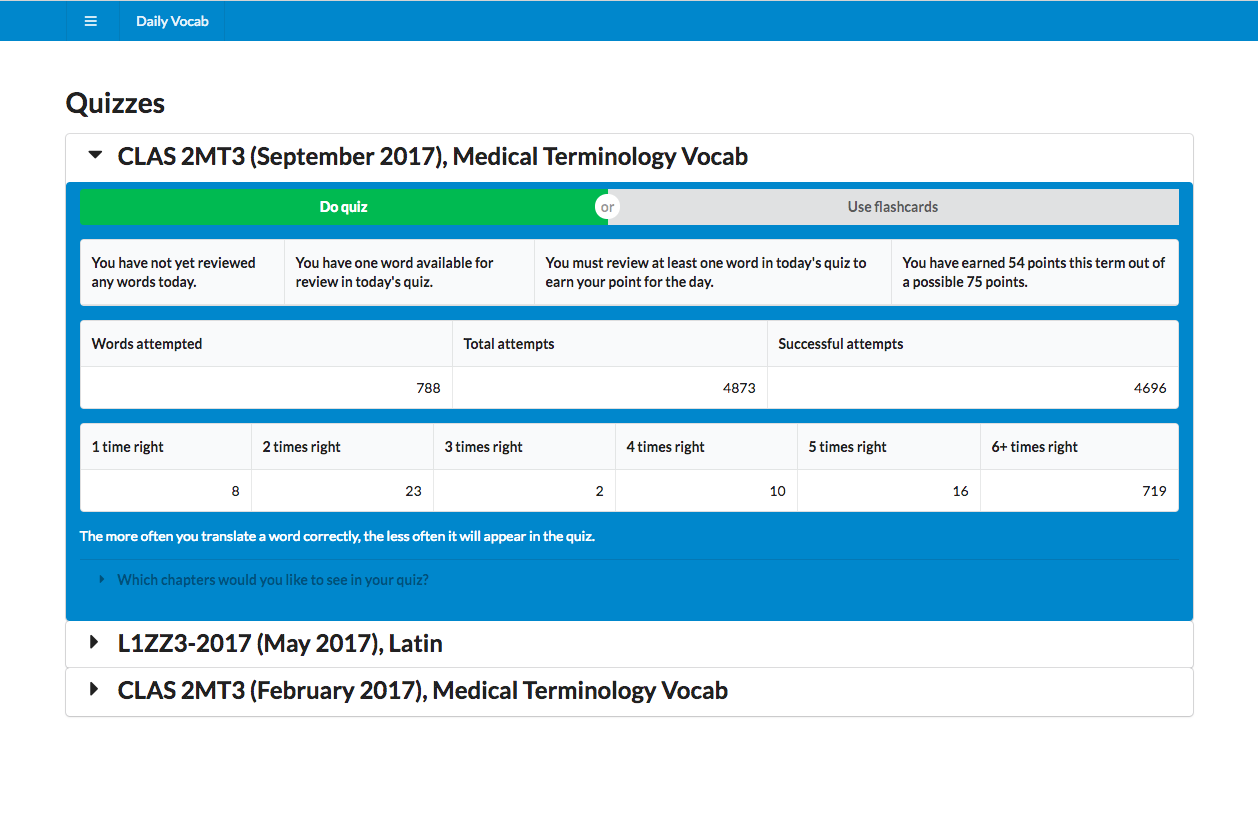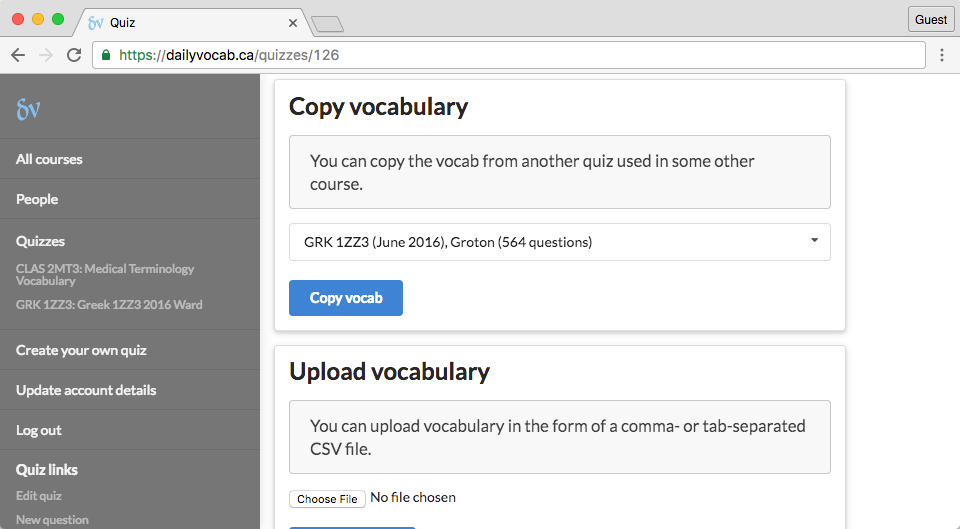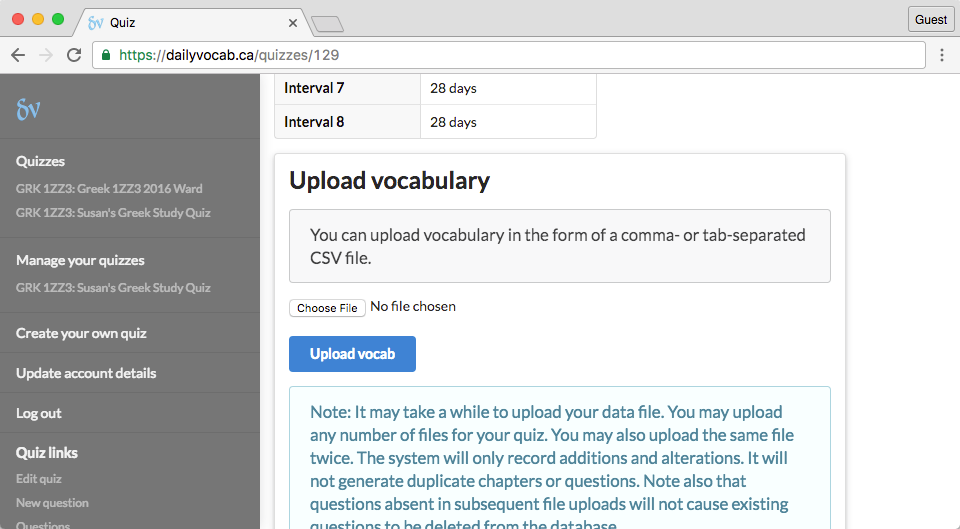Daily Vocab (dailyvocab.ca) is a learning tool for Latin and Greek words.
Daily Vocab's design is based on the learning technique of spaced repetition. Words are reviewed at increasingly longer intervals until they are permanently memorized. Spaced repetition improves long-term recall while minimizing the number of times each word needs to be reviewed.
You can use Daily Vocab as an independent language learner. You can also use it as an instructor or student in an academic course.
Daily Vocab was originally created at McMaster University in the Classics Department where it continues to be used every term by hundreds of students.
If you are an instructor who would like to use dailyvocab.ca for your class, please contact us at help@dailyvocab.ca.
If you are a student and you do not already have an account, your instructor will initiate the process for you. You will then receive an email containing a link that will allow you to activate your account and set your password.
Choose a password that is easy to remember but hard for another person to guess. Once you have a password, you will be able to sign in to dailyvocab.ca using your email address as your username.

Go to the sign-in page. Enter your email address and your password and click on "Sign in."

Once you sign in, you will immediately go to a page with information about all your wordlists. If your instructor has not yet set up wordlists, this page will be empty.

You will see information about each wordlist will appear in a boxes. These boxes can be hidden or revealed by clicking the black triangle in the top-left corner. At the top of this box, you will see the course code of the course that the wordlist is for (for example, LAT 1Z03) as well as the name of the word list.
You will see a big green button near the top of the box with the label, "Daily words." Click on this to start practicing.
Next to the "Daily words" button is another button with the label, "Extra practice (flashcards)." You can use the electronic flashcards at any time. You do not get points for reviewing the flashcards, but it can still be a helpful way to supplement your daily words.
Below these two buttons, there is a table with several fields:
Below this table is a second table with more statistics about your wordlist:
From your wordlists page, click on the big green button with the label, "Do wordlist."
In large type in the middle of the page, you will see the word you are being asked to translate. Enter your translation into the box beneath the word, and press enter.
The page will show you right away whether you translated the word correctly. If the sound on your computer is not muted, you will hear a sound indicating whether the word was correct. An icon will appear briefly beside the translation input box as well, indicating whether you got the word right.
If the systems detects that your translation is almost correct (for example, if you've made a minor typo), it will not count the word as wrong, but instead give you another chance to translate the word correctly.
If you get a word wrong, it will appear again in the wordlist after you have reviewed the other available words.
When you get a word right, another word will appear for you to translate until you have reviewed all the available words.
As you review words, the last four attempts will appear in a table below the input box. That table will show a list of valid translations as well as your own translation. An icon will show you whether you translated the word correctly.
You can practice vocabulary on your phone or tablet by using the website or by buying the app. If you use the website, you will need a continuous connection to the internet. With the app, you are able to work offline.

Students are invited to use the site on a regular basis to thoroughly learn the vocabulary for their course. Depending on how the instructor configures the word list, students are asked to sign in on 50 separate days during the term. The website gives students one point for every day when they correctly review the required number of words. The instructor can configure how many days a student must practice and how many words per day a student must successfully translate.
Daily Vocab uses spaced repetition. This means that the server keeps track of how many times in a row the student has correctly translated a word. The longer the streak, the larger the interval before that word appears again in the word list.
For example, if a student gets a word right once, they will normally see it again the next day. If they get a word right a second time, they will see it again after three days, and if they get it right again a third time, they will see it again after 7 days. If a student ever forgets a word and gets it wrong, they lose their streak for that word and start over at the first interval.
Spaced repetition allow students to focus their efforts on those words
The intervals are configurable by the instructor or wordlist owner. Though the default intervals work well, an instructor can shorten or lengthen intervals to suit their needs. For example, an instructor might want to shorten the intervals for the compressed summer term. Intervals can be specified in half-day increments.
There are three kinds of wordlists. First, there are course wordlists added by instructors for their students. Second, there are the student wordlists added by students, and associated with a course they are enrolled in. And third, there are personal wordlists that can be created, managed, and used independently of all courses.
You do not have to be enrolled in any course to create an account and use a personal wordlist. Personal wordlists are for independent study. Currently there is no cost to create an account and work with personal wordlists. We do however expect there soon be an app in the Apple App Store and in the Google Play Store for a small price.
Students wordlists are visible to instructors, and, with the permission of the author, the instructor may share the studend wordlist with the class.
Students are encouraged to create their own student or personal wordlists for help in studying. Feel free to create wordlists for other courses or for private study.
Click on the menu icon at the top of the page. The menu icon is a stack of three short horizontal bars. The side menu will appear on the left-hand side of the page. Click on "Create your own wordlist" in the side menu. Select the course you would like your wordlist to be associated with (your instructor will be able to see your wordlist) and give your wordlist a descriptive name. Then click "Create wordlist."
Instead of selecting a course, you can indicate that the wordlist is a personal wordlist.

There are a number of ways to add questions to your wordlist. You can add questions one-by-one using the web interface provided. You can copy the word list from another wordlist, or you can upload a spreadsheet in CSV or Excel format.
To add questions one-by-one, click on "0 questions" from your wordlist page and then click on "New word" in the menu. Fill out the form with a word or prompt and any number of valid translations or responses.
If you would like to remove a translation, click the "X" icon at the right end of the input box. If you would like to add a new translation, click on "+" icon near the bottom of the form. Once you have filled the form, click the "Create Question" button.
You can only create questions for existing units. A unit is a small subset of vocabulary in a wordlist. You can think of it as like a chapter in a book. Every wordlist is created with an empty first unit. You may add units by clicking on "Units" in the menu and then "New units." Fill out the form. Once you have added a units, you can add questions to them.
Continue in this way until you have created all your units and questions.

One way to add questions to your wordlist is to copy a world list from another wordlist that is already in the system.
From your "Manage wordlist" page, find the box entitled "Copy vocabulary" and choose the wordlist whose units and questions you would like to copy into your own wordlist. Then click "Copy vocab." It may take a few minutes to finishing copying the wordlist.

To add questions to your wordlist, you can upload a spreadsheet. We currently accept CSV files, Excel files, and Open Office files.
Find "Upload vocabulary" on your wordlist page, and click "Choose File." Select your file and then click "Upload vocab." It may take a few minutes to upload your vocabulary.
The format of your spreadsheet should be like this: the first column should have the unit number. The first row of each unit can specify the unit name in the second column. For the other rows, the second column should have a word or phrase you wish students to translate (the prompt), and the third and subsequent rows should have valid translations.
If you are preparing your wordlist in CSV format, it should look something like this:
1,"Introduction to Greek Verbs"
1,"αἴρω","I raise","I take up"
1,"ἀρῶ","I will raise","I will take up"
You can upload more than one spreadsheet for the same wordlist. Questions and units will be merged intelligently into your wordlist, removing duplicates.

If a student creates their own wordlist, no other students will be able to see it. However, instructors are able to see the wordlist and manage it and may choose to share it with other students. Students are encouraged to use the "Create your own wordlist" functionality to create wordlists for other courses, including courses in other departments.
Omittable prefixes are small words such as, "to," "I," "the," "a," "an" which often appear at the beginning of valid translations. For example, in a French wordlist, you might include the verb "faire" for which you might specify "to make" or "to do" as valid translations. Sometimes students omit the "to" part of the answer. If the owner of the wordlist wants answers such as "do" and "make" to be counted as correct, they can add "to" to the list of omittable prefixes for that wordlist.
This practice is highly recommended as a way to make wordlists more flexible and less frustrating for learners. For authors of wordlists, doing this also gets rid of the need to specify multiple variants of the same translation. In this case, the author of the wordlist could specify only two valid translations, "to make" and "to do," but these translations would cover "make" and "do" as well.
You can specify omittable prefixes from your wordlist page by clicking on "Edit wordlist" in the left-hand side menu under "Wordlist links" and then updating the form.

Another way for authors of wordlists to cover multiple possible valid translations without exhaustively listing them is by using parentheses to indicate optional parts of the translation.
For example, if your valid translation is "on the one hand...on the other hand," you may find slight variants acceptable and want to specify them in the word list. The recommended way to do this is to add parentheses around optional words, for example, "on (the) one hand...on the other (hand)".
Without parentheses, you would have to to list each possible variant separately. Parentheses also allow you to add extra information about word beyond the simple translation. For example, you specify a translation such as "yes (emphatic)". In this case, a student could type yes (emphatic) but they could also just type yes, and their answer would be counted as correct. In either case, the word list would respond by reminding the student of the extra nuance.
